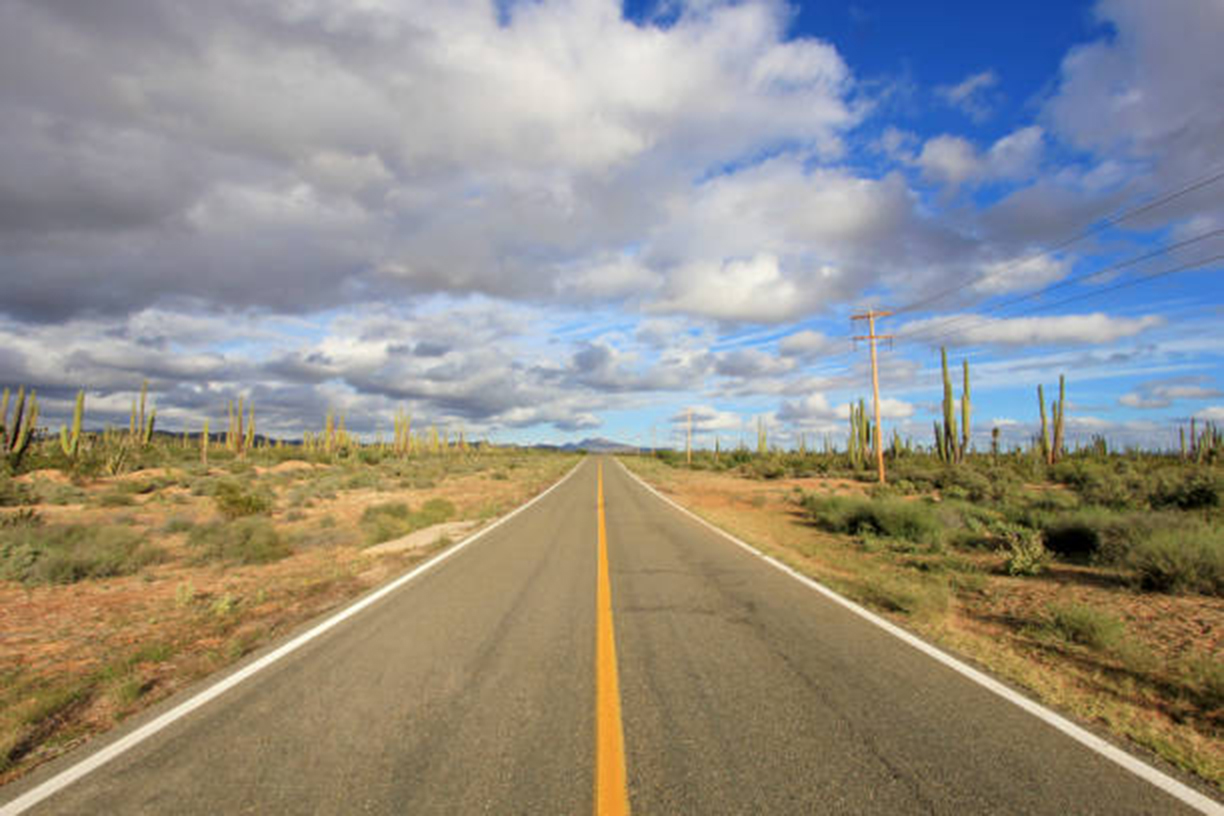Recently I took a trip to Baja California and drove it end to end – from Mexicali to Cabo San Lucas and everywhere in between, in the Mercedes Sprinter van I had converted myself. It was a trip of a lifetime, and I had so many unforgettable and unique experiences.
One of those unique experiences was driving Baja’s roads. It’s a completely different driving experience than what we gringos are used to in the United States. Driving in Baja is, shall we say, an adventure.
When you take to the roads in Baja, you need to develop a new mindset for what it’s like to drive on highways and byways. There are a lot of things you need to adapt to when south of the border.
There are no shoulders
On about 90% of the highways of Baja, for the most part, you get one travel lane, and that’s it. And for most of those miles – sorry, kilometers – the highway is not divided, so traffic moving in the opposite direction passes right next to you. One false move and your right hand tires will be on the desert gravel.
Now imagine an 18-wheeler approaching you and passing just inches from you on your left. Casey Jones you better watch your speed. Grip the wheel at 10 and 2 and focus past that big rig and just keep it on the straight (and narrow).
Roads are on a berm
For a good part of the peninsula the highways are up on a berm a meter or two above the surrounding desert. I’m not sure why this is, except that maybe by doing so heavy rains don’t create washes that flow over the roads. If you do wander off the roadway, you’ll roll. All the more reason to stay in your lane.
Roads are rough
Much of the roadways are not, shall we say, smooth as glass. They are rough surfaces, with much of the tar worn (melted?) away from the gravel base. Groovy. Here that sound? That’s the low whir of the road filing down your tire treads as you pass over it.
There are many potholes
There are lots and lots of potholes on the highways of Baja. Potholes large enough for a… pot. A few are large enough for a washtub. They’d like to munch on your tires. Fortunately, you’re often the only car on the road, so you can straddle them with your tires on either side of them. But sometimes, they are unavoidable. I remember one time I was heading downhill towards a bridge, and there was a deep break in the pavement as wide as my entire lane where the bridge connected to the rest of the roadway. I slowed way down, but even so there was a bone-shattering bang as I hit it that made me think my gas tank might fall off.
They like their speedbumps
When you come into a town in Baja, you’ll often be greeted with a series of speed bumps, or “topes”, as signs will warn. Having speed bumps as a means of controlling the speed of traffic – on the main roads – is a new experience for Americans. Many of these topes are no joke. If you’re not vigilant you, and your vehicle’s frame, will pay the price. In some towns, it seemed like there were so many speed bumps I thought they could rip them up and use them to fill all the potholes.
Tight turns
Most of Baja is a flat desert. Inexplicably, sometimes the highway would turn fairly sharply for no apparent reason. So sharply you sometimes need to slow way down. There’s plenty of room, I’d sometimes wonder to myself. Why not make a slow, gentle turn instead?
These tight turns are another reason to watch your speed and keep your eyes on the road.
Tight turns on mountain roads
Most of Baja is flat, but there are mountain passes. But the turns there can be just as sharp, with a steep drop off the non-existent shoulders. Lots of hairpins, that slowed me, in my 24′ long Sprinter, to a crawl (It doesn’t help that I tend to get a touch of acrophobia in such situations.). Not only are the turns sharp and the drops steep, but often there are also…
No guardrails on mountain roads
Yes it’s true, gringo. We don’t need no stinkin’ guardrails. They did have some, and I’m no highway engineer, but it seemed like they could have a lot more, and that the ones they did have could be a little higher. I didn’t trust that they would keep my van from tipping over them and careening down a precipice. Eyes on the road…eyes on the road.
Steep inclines
Mountain roads seemed steeper than what I’m used to in the States. If you need to go over a mountain, don’t waste time, just go over it, I guess the thinking goes. Your engine will get a good workout.
Steep declines
What goes up, must come down. And one northbound driver’s up is a southbound driver’s down. Right down. Downshift your camper van. Your brakes will get a good workout.
The road can oscillate
Going up a mountain and down the other side is understandable. Occasionally though, the roadway will warp across a seemingly flat expanse, causing a vehicle to bob like you’re on horseback. As always, watch your speed and keep an eye out for these dips.
Farm animals in the roadway
“Don’t drive at night” is the first piece of advice people give you when traveling to Baja. I’ve heard that one reason for this is that the free roaming livestock like to curl up on the roadway after dark, because it’s the warmest surface they can find.
But even during the daytime, cows, goats, horses, and donkeys can be too close for comfort. Oncoming traffic will alert you to an animal in the road by flashing their headlights at you. I remember one time as I was passing another vehicle, out of the corner of my eye I noticed a steer to my left just off the (shouldereless) roadway. I’m pretty sure my side mirror grazed his snout as I passed by.
High winds
High winds – 25 mph with much higher gusts – frequently blow across the Baja peninsula. This can be nerve-racking for someone who drives a high-top vehicle like a Mercedes Sprinter 170″ Extended. Winds gusts can blow your camper van around the roadway like a sailboat. In the Sprinter, it can activate “crosswind-assist”, a feature that activates braking on one side of the van to keep it in the lane. It’s still wrenching however, and after you get hit with that first gust, you can get spooked and are then constantly on alert for the next phantom blow. You slow down.
A different mindset
With all of this, you may say to yourself “Wow! Driving in Baja is a lot more dangerous than driving in the U.S.!” It is – if you expect to drive the way you do, and at the speeds we do, in America.
Driving in Baja requires a different mindset, a different approach to making your way down the highway. If you slow down (way down in some cases), and know what to expect, you’ll do fine. And there are so many reasons to explore Baja, so it’s definitely worth the effort.


